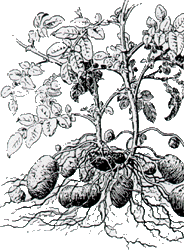


Fatimah Jackson, Ph.D.
is an African-American biological anthropologist. She studies common African crops such as cassava and sorghum. From these crops she develops insecticides.
Activity Booklet Contents
Activity Booklet is 24 pages.
Everyday Poisons
Discover the amazing number of poisons in everyday foods.Investigating Starch
Examine chemical properties of starch.African Arts
Use cassava to batik African symbols onto cloth.Green Travelers
Explore the world travels of everyday foods.New Wonders
Biography
Complete biography is 12 pages and includes a glossary.
When you eat French fries, you probably don't think
anything about them other than that they look good, smell good and taste good. When Fatimah Jackson eats French fries, she enjoys them, but she also thinks about the chemicals that potatoes naturally contain, and wonders what effect they may be having on her body.
"Plants are storehouses of chemical weapons," says Fatimah, a biologist and anthropologist at the University of Maryland at College Park who studies how plants and people affect one another. She's not talking about chemicals that are sometimes sprayed onto plants. The ones she studies are "just the God-given chemicals in the plants. One thing about plants is that they can't run very fast," Fatimah says with a wide smile. "They can't even run at all. So what they have developed are chemicals to draw insects and humans and animals that would help them survive toward them or to keep other animals away from them. So, the chemicals that keep you away are called repellents and the chemicals that draw you toward the plant are called attractants."

Before fruits and vegetables ripen, they are often green and bitter. These are signals to stay away from them. Not only will they taste bad, at that stage, the fruits or vegetables contain chemicals called repellents that are harmful to eat. Repellents are nature's way of getting you to leave the plant alone until it is ready to be eaten.
And, Fatimah points out, the appearance and the taste also protect the plant until it is ready to have you assist in its survival. "It needs to be picked in order to disperse its seeds, but it doesn't want to have its seeds dispersed before they are really mature. So, the fruit on the outside, the soft flesh, is really a mechanism to get the seed scattered all over the place to produce more trees or bushes to produce more fruit," she explains.
CD-ROM
Click on the picture to see an abbreviated version of the African Plant Explorer CD-ROM.
African Plant Explorer Video
Click on the picture to see an excerpt from the video.
"When I look at plants, I see both food and medicine. In fact, sometimes the two are intertwined. That is, what is eaten as food can have medicinal effects, and sometimes what we're calling a medicine, actually is also a food."
Biological anthropologist Fatimah Jackson takes viewers on an exotic journey from her lab at the University of Maryland to Uganda in central Africa as she studies how one of the world's most popular root crops, cassava, can be used as both food and medicine. Traveling with her 10 year-old son, Hasan, Fatimah teams up with horitculturist Olivia Maganyi, curator of the Makarere University herbarium, to conduct her research. Together, they travel to cassava research fields, outdoor markets, an international convention, and a rural farm to exchange views in English and Swahili with scientists, villagers and farmers.
Supplies in Kit
- Activity Booklet
- Biography of Dr. Fatimah Linda Collier Jackson
- 17 minute video
- 1 boxes Tapioca Flour
- 12 plastic pipets
- 7 plastic squeeze bottles
- Disposable gloves
- World Map
Permission is given to educators to reproduce these pages for classroom and training purposes only.